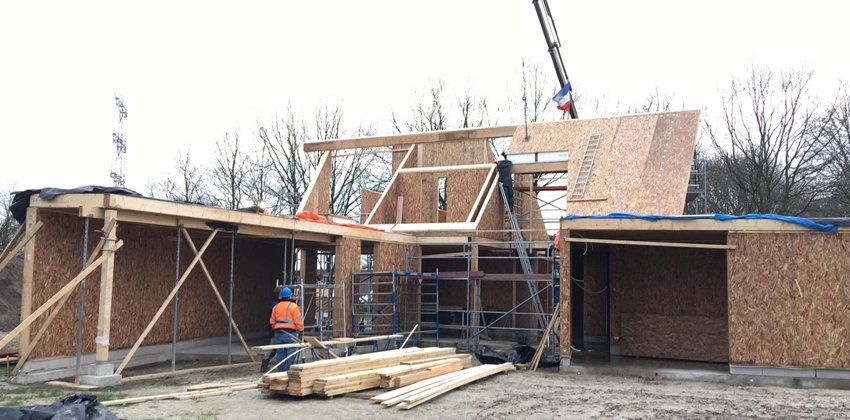
Circularity and Recycling: The Future of SIP Construction
The construction industry is responsible for around 40% of global carbon emissions and nearly one-third of all waste generated. In Europe, this challenge is driving a massive shift toward circular construction—a model where buildings are designed as material banks, waste is minimized, and resources are reused instead of discarded.
Structural Insulated Panels (SIPs) are emerging as a key enabler of this transition. Prefabricated, efficient, and recyclable, SIPs align perfectly with Europe’s goals for a circular economy. This blog explores how SIPs contribute to circular construction, their recycling potential, and why they represent the future of sustainable building.
What Is Circular Construction?
Circular construction goes beyond “green building.” It is about designing for:
- Resource Efficiency: Using fewer raw materials.
- Waste Reduction: Minimizing off-cuts and construction site waste.
- Reusability: Designing buildings for disassembly and material recovery.
- Recycling: Ensuring that end-of-life materials re-enter the value chain.
In short, circular construction transforms buildings from waste producers into material banks.
How SIPs Align with Circular Principles
- Reduced Waste During Construction
SIPs are precision-manufactured in factories using CNC machinery. This minimizes off-cuts and errors. Compared to traditional brick-and-block construction, SIP projects generate up to 60% less waste on site.
- Efficient Resource Use
Because SIPs combine structure, insulation, and airtightness in a single panel, fewer separate materials are needed. This simplifies supply chains and reduces embodied carbon.
- Design for Disassembly
SIPs can be dismantled and reused. Panels remain structurally sound after disassembly, allowing them to be repurposed in other projects or recycled.
- Recyclable Materials
- OSB Facings: Made from fast-growing timber, OSB is renewable and recyclable.
- Neopor® Core: Can be recycled into new insulation or plastic products.
- Adhesives: Current developments are focusing on more eco-friendly, recyclable bonding systems.
Recycling SIPs at End of Life
End-of-life management is critical for circular construction. SIPs offer clear recycling pathways:
- Separation: Panels can be dismantled into OSB and Neopor® components.
- OSB Recycling: Reprocessed into particleboard or biomass energy.
- Neopor® Recycling: Mechanically or chemically recycled into new insulation.
- Metal Connectors: Easily recovered and recycled.
Quacent is actively working with recycling partners to optimize these processes, ensuring SIPs support Europe’s circular economy vision.
The Business Case for Circular SIPs
Circularity is not just an environmental issue—it’s an economic opportunity:
- Lower Disposal Costs: Recycling reduces expensive landfill fees.
- Compliance Advantage: Developers gain an edge in tenders requiring circular construction.
- Market Value: Buyers and investors increasingly demand ESG-compliant housing with proven lifecycle benefits.
- Future-Proofing: Buildings designed for circularity avoid future retrofitting costs.
For developers and policymakers, SIPs provide a practical way to meet circular economy goals without sacrificing speed or cost efficiency.
Overcoming Challenges
While SIPs are well aligned with circular principles, challenges remain:
- Adhesive Recycling: Separating OSB and Neopor® fully is complex, though technologies are improving.
- Market Awareness: Many stakeholders are unfamiliar with SIP recyclability.
- Infrastructure: Recycling networks must expand to handle larger SIP volumes.
Quacent and partners are addressing these barriers by developing recycling protocols and participating in circular construction initiatives across Europe.
Looking Ahead
Circular construction will define the next decade of European building policy. Expect to see:
- Mandatory Circularity Metrics: LCAs and EPDs will increasingly require end-of-life scenarios.
- Design for Disassembly Standards: Buildings will be designed with explicit reuse and recycling plans.
- Integration with Modular Construction: Prefabricated SIP modules designed for multiple life cycles.
- Closed-Loop Supply Chains: Recycled SIP materials reintroduced into new panels.
SIPs are well positioned to thrive in this future because they already embody circular principles.
Conclusion
Circular construction is no longer optional—it is the future of Europe’s building industry. SIPs support this transition by reducing waste, optimizing resources, and offering recyclability at the end of life.
By choosing SIPs, developers and architects are not just building for today—they are building for the next life cycle. With Quacent’s commitment to sustainability and recycling innovation, SIPs are proving that circularity and prefabrication go hand in hand.
For policymakers, contractors, and homeowners, the message is clear: SIPs are not only a faster way to build—they are the circular way to build.





Add a comment